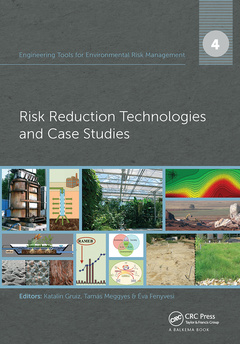Engineering Tools for Environmental Risk Management 4. Risk Reduction Technologies and Case Studies Engineering Tools for Environmental Risk Management Series
Coordonnateurs : Gruiz Katalin, Meggyes Tamás, Fenyvesi Éva

The four volumes of the book series "Engineering Tools for Environmental Risk Management" deal with environmental management, assessment & monitoring tools, environmental toxicology and risk reduction technologies. This last volume focuses on engineering solutions usually needed for industrial contaminated sites, where nature?s self-remediation is inefficient or too slow. The success of remediation depends on the selection of an increasing number of conventional and innovative methods. This volume classifies the remedial technologies and describes the reactor approach to understand and manage in situ technologies similarly to reactor-based technologies. Technology types include physicochemical, biological or ecological solutions, where near-natural, sustainable remediation has priority.
A special chapter is devoted to natural attenuation, where natural changes can help achieve clean-up objectives. Natural attenuation and biological and ecological remediation establish a serial range of technologies from monitoring only to fully controlled interventions, using ? just? the natural ecosystem or sophisticated artificial living systems. Passive artificial ecosystems and biodegradation-based remediation ? in addition to natural attenuation ? demonstrate the use of these ?green? technologies and how engineering intervention should be kept at a minimum to limit damage to the environment and create a harmonious ecosystem.
Remediation of sites contaminated with organic substances is analyzed in detail including biological and physicochemical methods.
Comprehensive management of pollution by inorganic contaminants from the mining industry, leaching and bioleaching and acid mine drainage is studied in general and specifically in the case of an abandoned mine in Hungary where the innovative technology of combined chemical and phytostabilization has been applied.
The series of technologies is completed by electrochemical remediation and nanotechnologies.
Monitoring, verification and sustainability analysis of remediation provide a comprehensive overview of the management aspect of environmental risk reduction by remediation.
This book series focuses on the state of knowledge about the environment and its conscious and structured application in environmental engineering, management and decision making.
1. Contaminated site remediation, role and classification of technologies
2. In situ soil remediation – the reactor approach
3. Natural attenuation in contaminated soil remediation
4. Ecoengineering tools – passive artificial ecosystems
5. Biodegradation-based remediation – overview and case studies
6. Traditional and innovative methods for physical and chemical remediation of soil contaminated by organic matter
7. Leaching, bioleaching and acid mine drainage: case study
8. Remediation technologies for metal-contaminated soil and sediment – an overview and a case study of combined chemical and phytostabilization
9. Electrochemical remediation for contaminated soil, sediments and groundwater
10. Elemental iron and other nanotechnologies for soil remediation
11. Planning, monitoring, verification and sustainability of soil remediation
Katalin Gruiz is Associate Professor at Budapest University of Technology, Budapest, Hungary.
She graduated in chemical engineering at Budapest University of Technology and Economics in 1975, received her doctorate in bioengineering and her Ph.D. in environmental engineering. Her main fields of activities are: teaching, consulting, research and development of engineering tools for risk-based environmental management, development and use of innovative technologies such as special environmental toxicity assays, integrated monitoring methods, biological and ecological remediation technologies for soil and water, both for regulatory and engineering purposes. Prof. Gruiz has published 70 scientific papers, 25 book chapters, 43 conference papers, and edited 9 books and a special journal edition. She has coordinated a number of Hungarian research projects and participated in European ones. Gruiz is a member of the REACH Risk Assessment Committee of the European Chemicals Agency. She is a full time associate professor at Budapest University of Technology and Economics and heads the research group of Environmental Microbiology and Biotechnology.
Tamás Meggyes is Research Coordinator in Berlin, Germany.
He is specialising in research and book projects in environmental engineering. His work focuses on fluid mechanics, hydraulic transport of solids, jet devices, landfill engineering, groundwater remediation, tailings facilities and risk-based environmental management. He has contributed to and organised several international conferences and national and European integrated research projects in Hungary, Germany, United Kingdom and USA. Tamás Meggyes was Europe editor of the Land Contamination and Reclamation journal in the UK and a reviewer of several environmental journals. He was invited by the EU as an expert evaluator to assess research applications and by Samarco Mining Company, Brazil, as a tailings management expert. In 2007, he was name
Date de parution : 12-2020
17.4x24.6 cm
Date de parution : 01-2019
17.4x24.6 cm
Thèmes d’Engineering Tools for Environmental Risk Management :
Mots-clés :
PRB; Organic Contaminants; Soil Contaminants; Soil Remediation; Soil Microbiota; Fly Ash; Moisture Content; Soil Phases; Nanoscale Iron Particles; Soil Washing; Transformer Oil; Soil Air; Low Permeability Soils; Bimetallic Nanoparticles; Redox Potential; RCR; Natural Attenuation; Electrokinetic Remediation; Electro-osmotic Flow; Electroosmotic Flow; ETV; Red Mud; Electrokinetic Treatment; Situ Bioremediation; Tailings Pond



